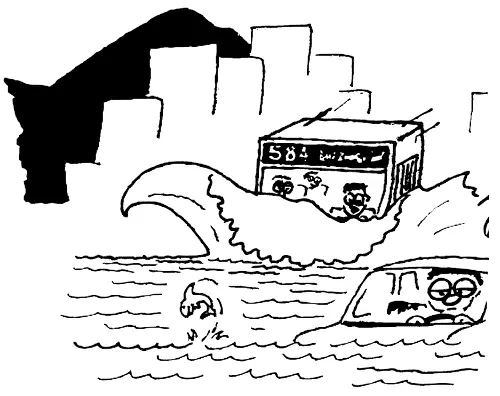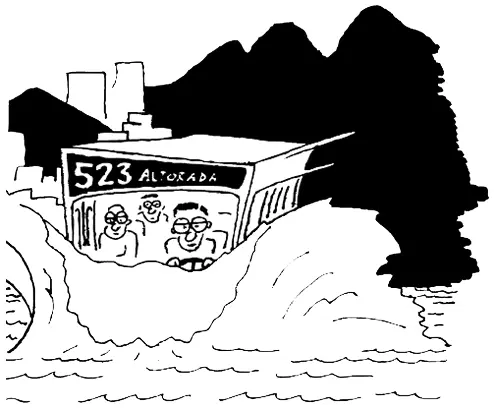• Volei:The only beach sport in which the participants actually pick an area furthest from the crowds, a skilled Carioca volei(volleyball) player will manage to include those bathers who are arriving or leaving the beach as his unsuspecting targets.
• Olha a asa!(Watch out for the hang glider!): Primarily played in Sao Conrado at Pepino (Cucumber) Beach, this «bather participation» activity is also available on Ipanema, Leblon, and Barra beaches, although on a smaller scale. Excellent for those days when you go solo to the beach, all you need to do is get comfortable, close your eyes, and listen for the password. When you hear «Olha a asa!», jump up, cover your head, then run towards the ocean.

• Body watching:The all-time favorite pastime for Cariocas anywhere, it takes on a whole new meaning at the beach (for obvious reasons)! All you need in order to play is a pair of dark glasses (optional for more discretion). The bodies are courtesy of the One Up Above, who, if you didn’t know by now, is also a Carioca. Obs.: There is a definite danger of whiplash while indulging in this game.
• Rangando(Eating): After so much activity you need never go hungry while at the beach, and the enormous number of beach vendors trampling around you will make sure you don’t forget it. Some beach delicacies that are available to choose from are:

The all-time favorite, though, amongst the truest of Cariocas is the biscoito de polvilho[bee ’skoy too gee poh ’vee lyoh] (air biscuit). These air biscuits are sold in packages of ten and come in two flavors — sweet and salty. What contributes to the success of this air biscuit is the mystery as to what it really is. Taking a bite of an air biscuit is like taking a bite of nothing, and the difference between the sweet and the salty is yet to be discerned. It is a good idea to eat these air biscuits accompanied by an ice cold cerva. Avoid eating them, though, when you are deep in conversation.
Step 10. Etiquette:If you think bumming a smoke, asking for a light, reading someone else’s newspaper, asking others to watch your belongings while you take a dip, borrowing suntan lotion and asking the person to rub it on your back are not examples of acceptable behavior at the beach, wake up and smell the coffee! How else would you ever approach that gorgeous gataor gatão?
Step 11. Meeting friends:When bumping into someone you frequently see at the beach, you should always achieve body contact (refer to Lesson 5, «Carioca Body Language») before saying:
«E aí, (insert person?s name), beleza?»: «So how’s it going, great?» or «Opa, e aí?»: «Hey, so what’s up?»
Your response should always be affirmative, even if your dog has just died. Acceptable conversation topics may range from the weather to the most recent episode on the novela das oito.
Step 12. A galera da praia[ah gah leh rah dah ’prrah vah]: After spending a few days at the beach abids you farewell bynd borrowing as many objects as possible, you will have acquired a group of acquaintances. These newly found friends are your galera da praia(beach crowd). A true Carioca will maintain a close relationship with the galera da praiaas long as there is sand under foot. Remember: if anyone from your galera da praiabids you farewell by saying, «Aparece lá em casa,»resist the temptation to follow up on the offer without confirming by telephone first, even if they set a specific date. (If you do, you’ll probably be met with a stunned look, and you will end up blowing your cover as a local! Refer to Lesson 5, «Carioca Body Language.») Before leaving the beach, be sure to embrace or kiss everyone on the cheek, saying:
«A gente se vê.» [ah ’gen tche see ’veh]? See ya around?
Step 13. When it's time to leave:When the sun sets either behind the mountains or over the horizon is the only truly acceptable time for a Carioca to leave the beach. Shake out your towels; close up your beach chairs; shut and disassemble your umbrella; put on those T-shirts, shorts and kangas; place all assorted items in the beach bag; kiss the galeraand tell each of them you’ll be calling; and pay off the tab with your new buddy — the beer vendor. (Don’t forget to give him a firm pat on the back and a thumbs-up!) Then head slowly for the sidewalk. When you are within five feet of your car, quicken your pace, throw everything in the trunk, remove the cardboard from your windshield, and drive off as quickly as possible. Don’t worry. The flanelinhawill only chase you for a few meters, or until he sees another freguês[freh ’gaysh] (customer) pulling out. Then head to your favorite botecofor another round with your galera doboteco(bar crowd).
Submarine driving:Due to the intense humidity in the summer months, Rio is subject to sudden heavy rains. These deluges seldom last over thirty minutes, and unless you live on a hill or in a valley, they are merely an inconvenience. Naturally, there are a few recommendations to be heeded if you should unfortunately find yourself outside your residence when it rains in Rio:
1. If you have any experience piloting submarines, you shouldn’t have any problem driving your car in Rio when it rains. A Carioca will drive through a flooded road as long as the water level does not go past his windshield. In order to avoid problems in this situation, just keep the clutch depressed with one foot, accelerate continuously with the other, while keeping the other foot (?!) on the brake. That way you won’?t float into the car in front of you, water will not enter your exhaust pipe, and you will save yourself the tremendous headache of dry cleaning expenses.

2. Be sure to keep your windows closed. If you don’t, you might get caught by surprise by a tidal wave produced by a bus. And if you’re not careful and the flood water level should reach the window, your car will sink, consequently ruining your CD collection.
3. If the currents begin to take your car, don’t panic. Just climb on top of your car and reach for the nearest passing tree branch. Then wait for the first person to come around with a boat or a surfboard.
4. Look out for snakes, leeches, rats, and «who knows whats» that often appear on flooded streets.
5. Be on the lookout for «flood pirates,» and do not accept any offers for assistance. If anyone should offer to help, it will probably be a set-up, and you could find yourself minus your possessions and your floating device.

6. If you should be on a bus, great. It is the safest and driest place to be, and it is where you will remain for the next few hours, crammed together with one hundred and ten other people.
7. If you find yourself struck in traffic when the rains hit, stop at the highest point on the road, lock your car, and have a few chopps, perhaps accompanied by a portion of batata frita, at the nearest boteco. Remember to have a cafezinhobefore returning to your car.
Читать дальше
















